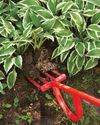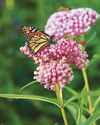
Adult monarchs that hatch in late summer or early fall do not mate or lay eggs-their only job is to migrate south to roosting grounds where they will overwinter. The map below left shows the paths they take. Southbound monarchs stop to feed along the way, storing fat that will sustain them for the flight and throughout the winter in their abdomens. In spring, these same monarchs begin the trip back north, laying eggs on milkweed plants in the southern United States before dying. Newly hatched caterpillars feed on the milkweed. When they reach adulthood, they continue the journey north, feeding and laying eggs along the route until the third or fourth generation reaches the home of its ancestors from the previous year.
This process takes a lot of energy. Loss of wildlife habitat has been detrimental to the monarch, both in nectar plants for adult butterflies and milkweed host sources for feeding caterpillars. Monarch Watch, an education, conservation and research organization dedicated to preserving this butterfly's population, has established the Monarch Waystation program to encourage home and public gardeners to feed and house these insects along their migration routes. You may already have most of the features of a successful waystation in your garden.
Monarch migration
This story is from the Issue 179 - October 2024 edition of Garden Gate.
Start your 7-day Magzter GOLD free trial to access thousands of curated premium stories, and 9,000+ magazines and newspapers.
Already a subscriber ? Sign In
This story is from the Issue 179 - October 2024 edition of Garden Gate.
Start your 7-day Magzter GOLD free trial to access thousands of curated premium stories, and 9,000+ magazines and newspapers.
Already a subscriber? Sign In

Spinach - Learn the secrets to growing this tasty green in spring and fall.
If you're one of those gardeners who can't wait to get started in spring and hates to throw in the trowel in fall, spinach is the perfect shoulder season crop. This mild, earthy-flavored green comes in many varieties, ranging from crinkly-leafed savoys to slightly textured semi-savoys and the flat, smooth-leafed types. Colors can be dark green, light green and even red-veined. Here's how to get the most of it every year.

Why Bulb Depth Matters - Dig deep enough to ensure your plants stand tall and live the longest
When you're planting bulbs, it's tempting to just dig a hole as deep as your trowel will reach easily, nestle the bulb in, cover it up and move on. But the fact is, each type of bulb will flower best and thrive at a different depth.A good rule of thumb is to plant a bulb two to three times its height. One reason planting depth is important is because it helps to keep the bulbs protected from fluctuations in temperature that happen closer to the surface.

GARDEN ESSENTIALS
FALL GARDEN CLEANUP TOOLS

Saving Seeds
Saving flower seeds is a great way to get more plants with almost no investment. It's easy to do. Here's how to save seeds from some of your favorite annuals as the growing season winds down.

Cucumber Trellis Flop
I watched cucumber trellis growers online for several seasons with envy. What a brilliant way to save space in raised garden beds and make it look fancy! Finally, I was sold and decided to try it in my garden.

9 Tough Perennials for Clay Soil
Whether you garden in the nutrient-poor red clay of the Southeast, the calcium combined-with-clay caliche of the West or something in between, the common denominator is that clay soil is difficult to grow in. Why? Tiny particles of clay hold tightly together, slowing drainage and limiting the amount of oxygen that can reach plant roots. You've seen the resultsanemic-looking or rotting plants.

Garden Fences
Discover the perfect blend of functionality, style, and materials for your ideal fence.

A GARDEN OF STORIES
Learn plant and project tips from a couple who's been gardening here for nearly 50 years.

Switchgrass
Adaptable switchgrass goes with the flow.

Establish a Monarch Waystation
Did you know that a single monarch butterfly can migrate up to 3,000 miles? That's a lot of ground to cover! This amazing insect makes a fascinating journey, unlike any other butterfly.